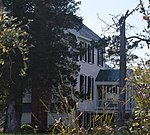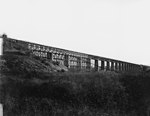The Battle of Amelia Springs, Virginia was an engagement between the Union Army (Army of the Shenandoah, Army of the Potomac and Army of the James) and Confederate Army of Northern Virginia that occurred on April 5, 1865 during the Appomattox Campaign of the American Civil War. It was followed by a second rear guard action near the same location on the night of April 5, 1865 and morning of April 6, 1865 during the Union Army pursuit of the Confederate forces (Army of Northern Virginia and Richmond local defense forces) which were fleeing westward after the fall of Petersburg and Richmond, Virginia at the Third Battle of Petersburg (sometimes shown as the Breakthrough at Petersburg) on April 2, 1865. The actions took place just prior to the Battle of Sailor's Creek (sometimes shown as "Sayler's Creek") on April 6, 1865. That battle would be the last major engagement between the Union Army under the overall direction of Union General-in-Chief, Lt. Gen. Ulysses S. Grant, and General Robert E. Lee's Army of Northern Virginia before that Confederate army's surrender at Appomattox Court House, Virginia on April 9, 1865.
On April 5, 1865, Confederate cavalry under the command of Brig. Gen. Martin Gary, reinforced by cavalry from the divisions of Maj. Gen. Thomas L. Rosser and Colonel Thomas T. Munford, which were under the overall command of Maj. Gen. Fitzhugh Lee, counterattacked a brigade of Union cavalry led by Brig. Gen. Henry E. Davies, Jr. Davies's brigade was part of the division commanded by Maj. Gen. George Crook, which in turn was under the overall command of Maj. Gen. Philip Sheridan. Davies's force was returning from a scout during which they burned Confederate wagons in the vicinity of Paineville, Virginia (Paineville area of Amelia County, Virginia), about 7 miles (11 km) north of Jetersville, Virginia. The wagons were carrying supplies and equipment for the Army of Northern Virginia. The running fight after the Paineville action started 3 miles (4.8 km) north of Amelia Springs and continued through Amelia Springs almost to Jetersville, Virginia on the South Side Railroad. Jetersville, which was 6 miles (9.7 km) southwest of Amelia Court House, Virginia where Lee's forces were concentrating, had been held by Sheridan's forces since the day before. The battle was inconclusive in that the Confederate forces had to return to Amelia Springs when Davies's troops were able to join with other Union forces as they approached Jetersville. During the night of April 5, 1865, Union Army divisions under the command of Brig. Gen. Nelson A. Miles and Maj. Gen. Gershom Mott fought a minor and inconclusive action against the Army of Northern Virginia rear guard commanded by Maj. Gen. John B. Gordon near Amelia Springs.Although casualties for both sides in both engagements have been stated to be light and about even at less than 250 combined, the Union commanders reported suffering 158 casualties. The Confederates presumably suffered fewer than 100. In addition, Davies's men took over 300 Confederate prisoners in the Paineville action immediately preceding the counterattack which precipitated the running battle through and beyond Amelia Springs almost to Jetersville.





